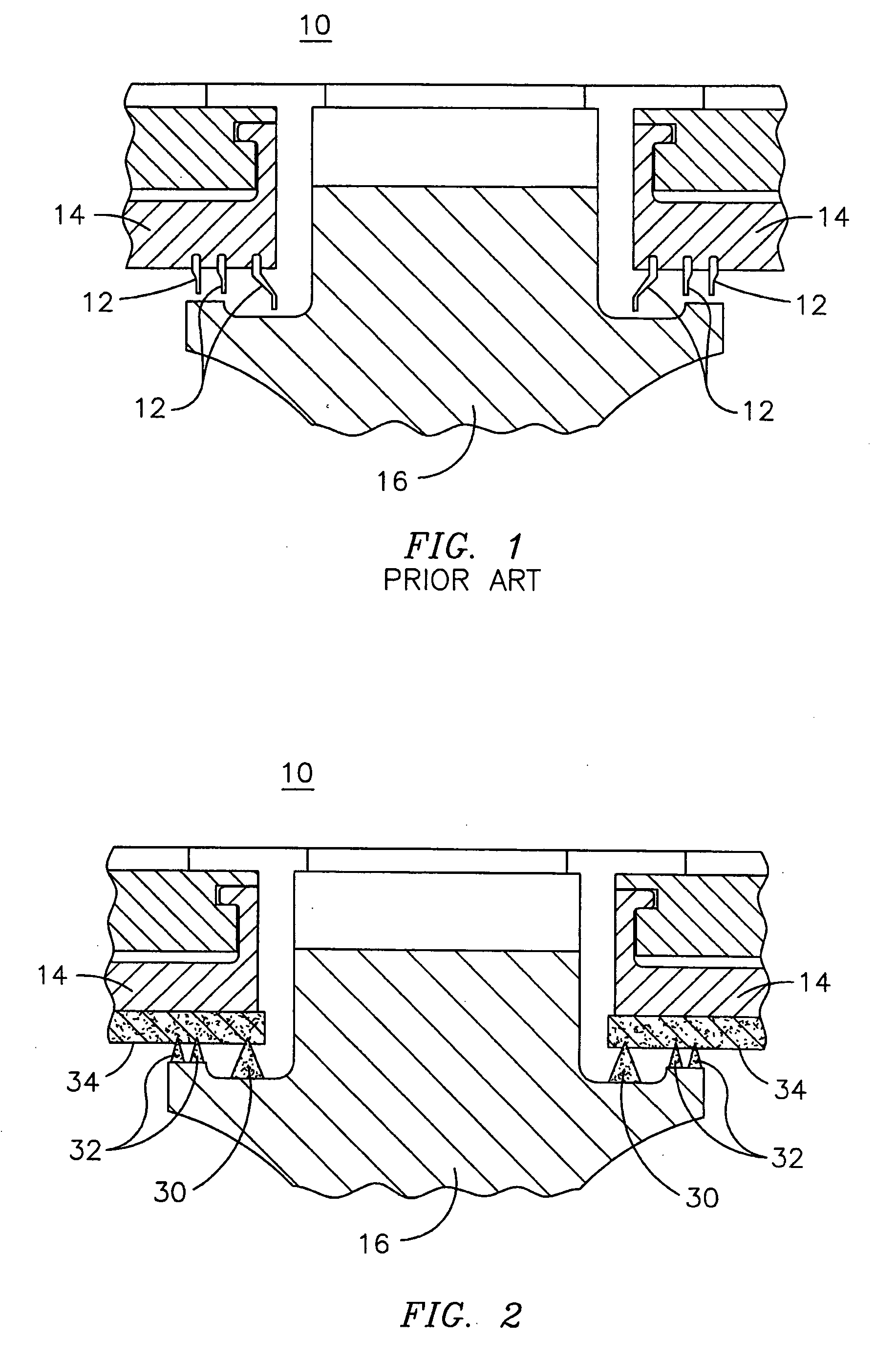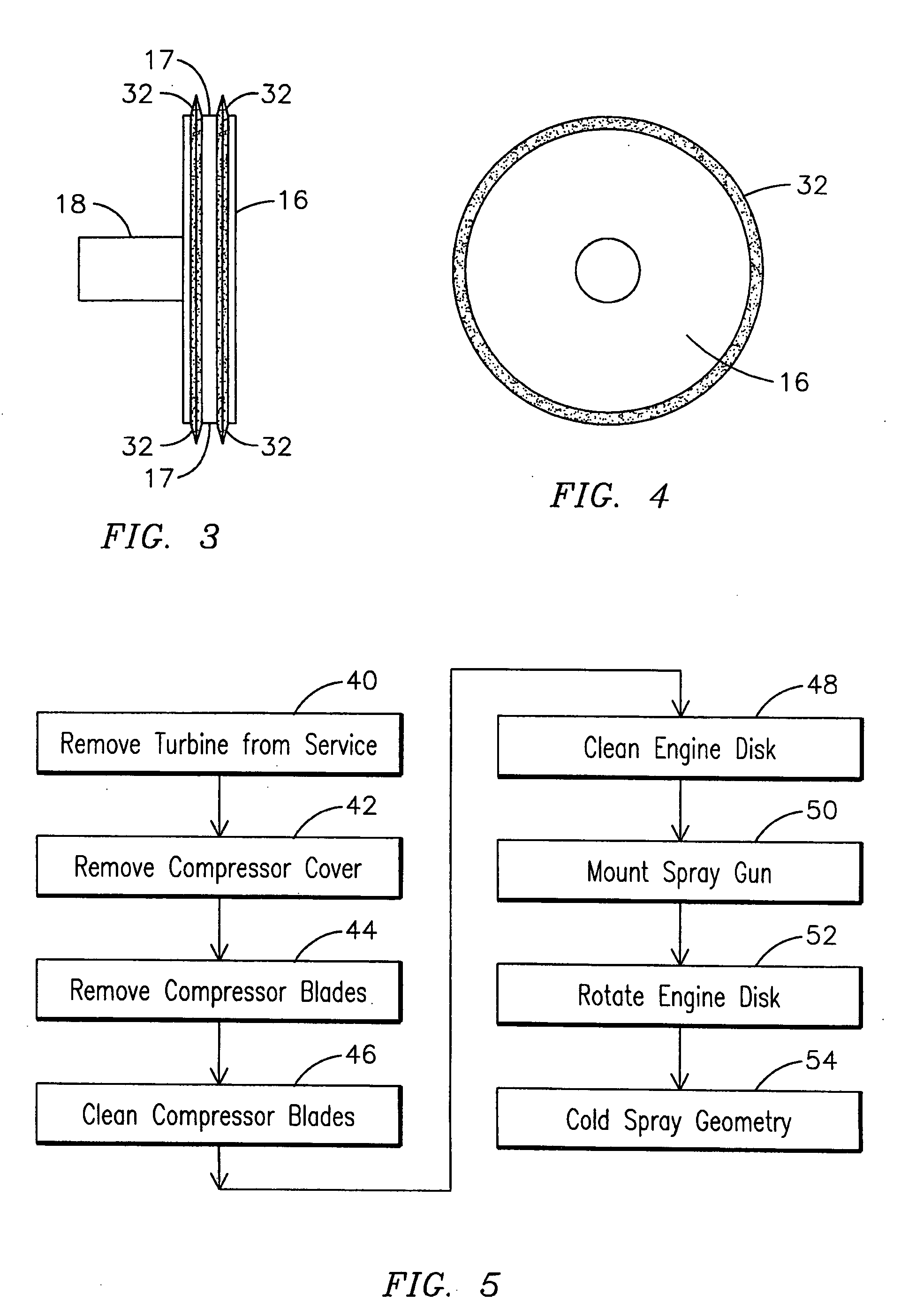Cold spray process for seal applications
a technology of cold spraying and sealing, applied in the direction of liquid fuel engines, machines/engines, mechanical equipment, etc., can solve the problems of reducing sealing efficiency, metallic debris that can damage downstream airfoils, and metal strips that tend to mushroom or flatten
- Summary
- Abstract
- Description
- Claims
- Application Information
AI Technical Summary
Problems solved by technology
Method used
Image
Examples
example 1
[0026] In this example, parallel ridges, such as ones used to form ridges 32 shown in FIG. 3, of 316L stainless steel were sprayed onto a flat plate of 4340 steel using a cold-spray technique. The spray conditions were varied slightly between ridges and the efficacy of each spray condition was evaluated by later cutup and metallography of the sprayed ridges. The spray conditions used for each ridge are listed in Table 1. A commercial 316L stainless steel powder with a sieve size predominantly between 11 and 38 microns was used for all spray trials.
TABLE 1Cold Spray Conditions†Measured ParticleGun Traverse RateNumberVelocityRidge #(meters / minute)of Passes(meters / second)118.7150610-7402 9.5100610-740
†Common spray conditions were as follows:
Nitrogen pressure: 3.25 MPa
Nitrogen temperature: 550° C.
Nitrogen flow rate: 85 cubic meters / hour
Gun nozzle exit diameter: 6.4 mm
[0027] The gun was translated 150 microns laterally after each subsequent pass to deposit the next pass (i.e., the...
example 2
[0028] In this example, two concentric ridges, such as ones used to form ridges 32 in FIG. 3, of 316L stainless steel were sprayed onto a 15 cm diameter disk of 4340 steel using a cold-spray technique. The spray conditions were varied slightly for each ridge, with the conditions used listed in Table 2. A commercial 316L stainless steel powder with a sieve size predominantly between 11 and 38 microns was used for all spray trials.
TABLE 2Cold Spray Conditions†Measured ParticleGun Traverse RateNumberVelocityRidge #(meters / minute)of Passes(meters / second)144450580-730231300580-730
†Common spray conditions were as follows:
Nitrogen pressure: 3.25 MPa
Nitrogen temperature: 550° C.
Nitrogen flow rate: 85 cubic meters / hour
Gun nozzle exit diameter: 6.4 mm
[0029] The gun was translated 150 microns laterally after each subsequent pass to deposit the next pass (i.e., the step size was 150 microns). No cutup or metallography was done on the ridges deposited onto the disk, but the cold-sprayed t...
PUM
| Property | Measurement | Unit |
|---|---|---|
| Width | aaaaa | aaaaa |
| Width | aaaaa | aaaaa |
| Temperature | aaaaa | aaaaa |
Abstract
Description
Claims
Application Information
 Login to View More
Login to View More - R&D
- Intellectual Property
- Life Sciences
- Materials
- Tech Scout
- Unparalleled Data Quality
- Higher Quality Content
- 60% Fewer Hallucinations
Browse by: Latest US Patents, China's latest patents, Technical Efficacy Thesaurus, Application Domain, Technology Topic, Popular Technical Reports.
© 2025 PatSnap. All rights reserved.Legal|Privacy policy|Modern Slavery Act Transparency Statement|Sitemap|About US| Contact US: help@patsnap.com



